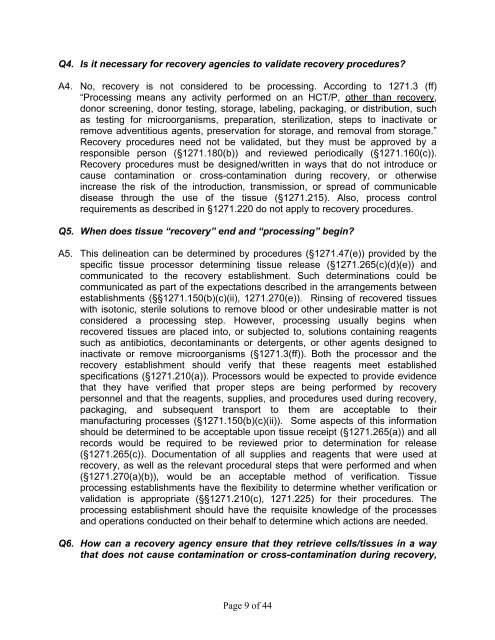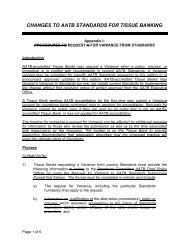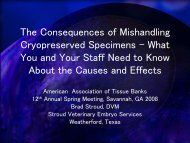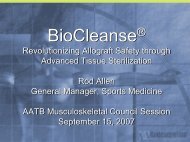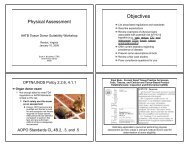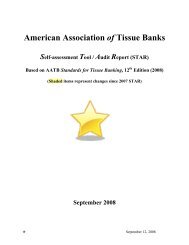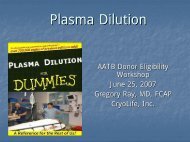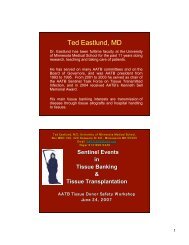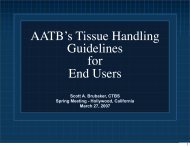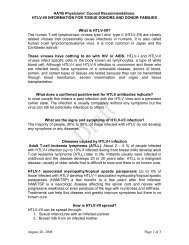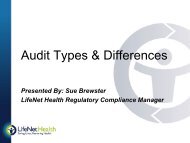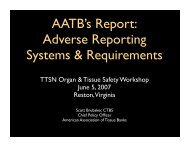Guidance Document - American Association of Tissue Banks
Guidance Document - American Association of Tissue Banks
Guidance Document - American Association of Tissue Banks
- No tags were found...
You also want an ePaper? Increase the reach of your titles
YUMPU automatically turns print PDFs into web optimized ePapers that Google loves.
Q4. Is it necessary for recovery agencies to validate recovery procedures?A4. No, recovery is not considered to be processing. According to 1271.3 (ff)“Processing means any activity performed on an HCT/P, other than recovery,donor screening, donor testing, storage, labeling, packaging, or distribution, suchas testing for microorganisms, preparation, sterilization, steps to inactivate orremove adventitious agents, preservation for storage, and removal from storage.”Recovery procedures need not be validated, but they must be approved by aresponsible person (§1271.180(b)) and reviewed periodically (§1271.160(c)).Recovery procedures must be designed/written in ways that do not introduce orcause contamination or cross-contamination during recovery, or otherwiseincrease the risk <strong>of</strong> the introduction, transmission, or spread <strong>of</strong> communicabledisease through the use <strong>of</strong> the tissue (§1271.215). Also, process controlrequirements as described in §1271.220 do not apply to recovery procedures.Q5. When does tissue “recovery” end and “processing” begin?A5. This delineation can be determined by procedures (§1271.47(e)) provided by thespecific tissue processor determining tissue release (§1271.265(c)(d)(e)) andcommunicated to the recovery establishment. Such determinations could becommunicated as part <strong>of</strong> the expectations described in the arrangements betweenestablishments (§§1271.150(b)(c)(ii), 1271.270(e)). Rinsing <strong>of</strong> recovered tissueswith isotonic, sterile solutions to remove blood or other undesirable matter is notconsidered a processing step. However, processing usually begins whenrecovered tissues are placed into, or subjected to, solutions containing reagentssuch as antibiotics, decontaminants or detergents, or other agents designed toinactivate or remove microorganisms (§1271.3(ff)). Both the processor and therecovery establishment should verify that these reagents meet establishedspecifications (§1271.210(a)). Processors would be expected to provide evidencethat they have verified that proper steps are being performed by recoverypersonnel and that the reagents, supplies, and procedures used during recovery,packaging, and subsequent transport to them are acceptable to theirmanufacturing processes (§1271.150(b)(c)(ii)). Some aspects <strong>of</strong> this informationshould be determined to be acceptable upon tissue receipt (§1271.265(a)) and allrecords would be required to be reviewed prior to determination for release(§1271.265(c)). <strong>Document</strong>ation <strong>of</strong> all supplies and reagents that were used atrecovery, as well as the relevant procedural steps that were performed and when(§1271.270(a)(b)), would be an acceptable method <strong>of</strong> verification. <strong>Tissue</strong>processing establishments have the flexibility to determine whether verification orvalidation is appropriate (§§1271.210(c), 1271.225) for their procedures. Theprocessing establishment should have the requisite knowledge <strong>of</strong> the processesand operations conducted on their behalf to determine which actions are needed.Q6. How can a recovery agency ensure that they retrieve cells/tissues in a waythat does not cause contamination or cross-contamination during recovery,Page 9 <strong>of</strong> 44


